A Relative Frequency Distribution Shows
Probability Distributions > Relative Frequency Distribution
What is a Relative frequency distribution?
A relative frequency distribution is a blazon of frequency distribution.
The showtime paradigm here is a frequency distribution table. A frequency distribution table shows how often something happens. In this item table, the counts are how many people utilise certain types of contraception.
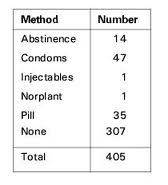
With a relative frequency distribution, we don't want to know the counts. We want to know the percentages. In other words, what percentage of people used a item grade of contraception?
This relative frequency distribution table shows how people's heights are distributed.
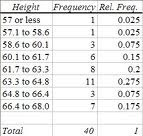
Annotation that in the right cavalcade, the frequencies (counts) have been turned into relative frequencies (percents). How y'all practise this:
- Count the total number of items. In this chart the full is 40.
- Divide the count (the frequency) by the full number. For example, 1/40 = .025 or 3/40 = .075.
This information can besides be turned into a frequency distribution nautical chart. This nautical chart shows the relative frequency distribution tabular array and the frequency distribution chart for the data. How to nosotros know information technology's a frequency chart and non a relative frequency chart? Look at the vertical axis: information technology lists "frequency" and has the counts:
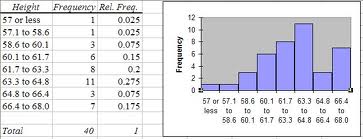
This next chart is a relative frequency histogram. You know it'southward a relative frequency distribution for two reasons:
- It's labeled as relative frequency (which all good charts should be!).
- The vertical axis has percentages (equally decimals, .one, .2, 3 …)instead of counts (1, 2, iii…).
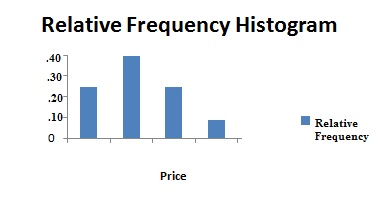
How to Make a Relative Frequency Tabular array
Need help with a homework question? Check out our tutoring page!
Making a relative frequency table is a 2 stride process.
Pace i: Brand a tabular array with the category names and counts.
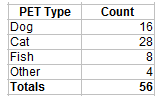
Stride two: Add a second column called "relative frequency". I shortened it to rel. freq. here for space.
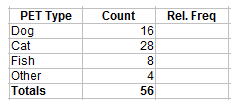
Step iii: Effigy out your first relative frequency by dividing the count by the full. For the category of dogs nosotros have 16 out of 56, and so 16/56=0.29.

Footstep iv: Complete the residue of the table past figuring out the remaining relative frequencies.
Cats = 28 / 56 = .5
Fish = eight / 56 = .14
Other = four / 56 = 0.07
Don't forget to put the full at the bottom of the rel. freq. cavalcade: .29 + .5 + .14 +.07 = 1.
Note: The usual style to complete the table is with decimals or percents. Yet, it'due south still technically correct to simply go out the ratios (i.eastward. 28/56) in the column (that fashion you don't accept to do the math!).
Cumulative Relative Frequency
To find the cumulative relative frequency, follow the steps above to create a relative frequency distribution table. As a final step, add up the relative frequencies in some other column. Here'due south the column to the right is labeled "cum. rel. freq.")

The first entry in the column is the same as the offset entry in the rel.freq column (.29).
Next, I added the showtime and 2d entries to get 0.29 + 0.50 = 0.79.
Adjacent, I added the first, 2d and 3rd entries to get 0.29 + 0.50 + 0.xiv = 0.93.
Finally, I added the get-go, second, 3rd and fourth entries to get 0.29 + 0.50 + 0.14 + 0.07 = 1.
References
Agresti A. (1990) Categorical Data Assay. John Wiley and Sons, New York.
Klein, G. (2013). The Cartoon Introduction to Statistics. Hill & Wamg.
Levine, D. (2014). Fifty-fifty You Tin Learn Statistics and Analytics: An Easy to Understand Guide to Statistics and Analytics 3rd Edition. Pearson FT Press
---------------------------------------------------------------------------
Need help with a homework or test question? With Chegg Study, you lot can get footstep-by-pace solutions to your questions from an expert in the field. Your first xxx minutes with a Chegg tutor is free!
Comments? Need to mail service a correction? Delight Contact U.s.a. .
A Relative Frequency Distribution Shows,
Source: https://www.statisticshowto.com/probability-and-statistics/statistics-definitions/relative-frequency-distribution/
Posted by: cartwrightpospot.blogspot.com


0 Response to "A Relative Frequency Distribution Shows"
Post a Comment